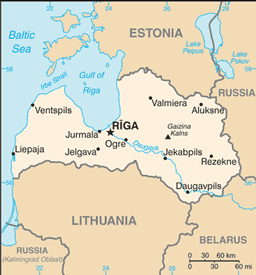Latvia
 Latvia is country of Europe located in eastern Europe.
Latvia is country of Europe located in eastern Europe.
Details
| Official Name: | Republic of Latvia |
| Capital: | Riga |
| Total area: | 65 000 km2 |
| GDP per capita: | $18,100 |
| Native Language: | Latvian |
| Government: | Parliamentary Democracy |
| Population: | 1,911,108 |
| Major Religion: | Evangelical Lutheranism |
| Monetary Unit: | Euro (EUR) |
Latvia regained independence from the Soviet Union in 1991. Situated on the Baltic coast, Latvia is a low-lying country with large forests that supply timber for construction and paper industries. The environment is rich in wildlife. Latvia also produces consumer goods, textiles and machine tools. The country attracts tourists from all over Europe.
Ethnically, the population is 59% Latvian and 29% Russian, and more than a third live in the capital Riga. Founded in 1201, Riga is the largest city in the three Baltic states with a population of 730 000. Its Freedom Statue is one of the highest monuments in Europe, at 43 metres.
The 100-seat unicameral Latvian Parliament, the Saeima , is elected by direct, popular vote every four years. The president is elected by the Parliament, also every four years.
Among the best-known Latvians are the expressionist painter Mark Rothko and the contemporary composer Peteris Vasks.
Characteristic specialities of Latvian cuisine are speķapīrādziņi (bacon pies) and a refreshing, cold sour cream soup.
Health & Welfare
Social insurance and benefits programs are being developed including free choice of provider, free drugs and prescriptions, and inclusive health insurance for all citizens.
Economy & Jobs
Service, tourism, shipping, trading, and agriculture.
Main Attractions
Riga, Bauska castle, Jurmala towns, Kuldiga historic town, and Sigulda medieval castles.
Immigration
Latvian citizenship can be acquired in a number of ways. The most common are by descent, birth, marriage, extension of award, and business. Tourist, student, and work visas are also available as the immigration by real estate is provided.
Economy
Latvia is a small, open economy with exports contributing nearly a third of GDP. Due to its geographical location, transit services are highly-developed, along with timber and wood-processing, agriculture and food products, and manufacturing of machinery and electronics industries. Corruption continues to be an impediment to attracting foreign direct investment and Latvia's low birth rate and decreasing population are major challenges to its long-term economic vitality. Latvia's economy experienced GDP growth of more than 10% per year during 2006-07, but entered a severe recession in 2008 as a result of an unsustainable current account deficit and large debt exposure amid the softening world economy. Triggered by the collapse of the second largest bank, GDP plunged 18% in 2009. The economy has not returned to pre-crisis levels despite strong growth, especially in the export sector in 2011-12. The IMF, EU, and other international donors provided substantial financial assistance to Latvia as part of an agreement to defend the currency's peg to the euro in exchange for the government's commitment to stringent austerity measures. The IMF/EU program successfully concluded in December 2011. The government of Prime Minister Valdis DOMBROVSKIS remained committed to fiscal prudence and reducing the fiscal deficit from 7.7% of GDP in 2010, to 2.7% of GDP in 2012. The majority of companies, banks, and real estate have been privatized, although the state still holds sizable stakes in a few large enterprises, including 99.8% ownership of the Latvian national airline. Latvia officially joined the World Trade Organization in February, 1999 and the EU in May 2004. Latvia intends to join the euro zone in 2014.
Immigration possibilities
If you are interested in immigration to Latvia, click here, and also get acquainted with the relevant migration documents.